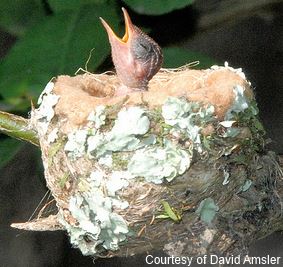
Hummingbirds - Nectar Recipe, Gardens, Migration, Feeders, Fun Facts and More!
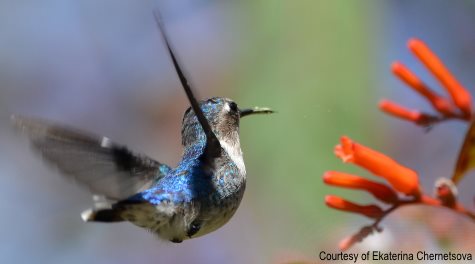
Who doesn't like hummingbirds? Mean people, we guess?! Really, have you ever heard anyone say, "Bah, hummingbirds!"
Zippin' and hummin' around our flowers and feeders, these tiny little birds are an endless source of joy and amusement for all. Let's explore the world of our beloved hummers and learn some interesting facts about these little flying jewels.
Depending if you're a taxonomic lumper or splitter, there are somewhere between 325-340 species of hummingbirds in the world, making them the second largest family of birds after flycatchers.
The family is divided into two sub-families: Phaethornithinae (Hermits) currently composed of 34 species, and the larger group, Trochilinae (Trochilines or "typical" hummingbirds) composed of the remaining 291-306 species.
|
Scientific Classification Kingdom: Animalia |
|
Hummingbird Range
Hummingbirds are only found in North, Central, and South America. Their range extends from southern Canada and Alaska in the north, to Tierra del Fuego in the south. They are also found in the islands of the West Indies.
The majority of hummingbird species occur in Central and South America with the greatest diversity within the latitudes of 10° North and 10° South of the equator. The largest number of species are found in Ecuador, Columbia & Peru.
Of the 21 species of hummingbirds that reach the U.S., 16 regularly breed here, one is a common visitor, and four others are classified as vagrants - only occasionally present.
The most common hummingbird east of the Mississippi in the U.S. is the Ruby-throated Hummingbird (Archilochus colubris).
Common Western U.S. Hummingbirds
Black-chinned hummingbird (Archilochus alexandri)
Costa's hummingbird (Calypte costae)
Anna's hummingbird (Calypte anna)
Broad-tailed Hummingbird (Selasphorus platycercus)
Rufous Hummingbird (Selasphorus rufus)
Allen's Hummingbird (Selasphorus sasin)
Calliope Hummingbird (Stellula calliope)
These species are typically found in the extreme southwestern U.S. (parts of AZ, NM, & TX)
Violet-crowned Hummingbird (Amazilia violiceps)
Lucifer Hummingbird (Calothorax lucifer)
Broad-billed Hummingbird (Cynanthus latirostris)
Blue-throated Hummingbird (Lampornis clemenciae)
Magnificent Hummingbird (Eugenes fulgens)
So what makes a hummingbird a hummingbird?
Hummingbirds are unique for their:
- Agility in flight,
- Extremely brilliant, iridescent plumage,
- Long, specialized bills,
- And general small size
Let's explore some of these & other unique characteristics:
Hummingbird Flight
In flight, a hummingbird's wing is only visible as a blur, because of the speed of its wing beat, between 10 to 80 times per second for normal flight. The speed depends on the size of the bird, with the highest wing-beat rates occurring in the smaller species.
The normal flight speed of hummingbirds is between 25-30 mph. During display dives, wing beats may be as high as 200 beats per second and birds reaching speeds of up to 65mph!
Hummingbirds have many skeletal and flight muscle adaptations that allow for hovering and high maneuverability in flight.
They have compact, strongly muscled bodies. Muscles make up 25-30% of their body weight - like tiny little Schwarzeneggers!
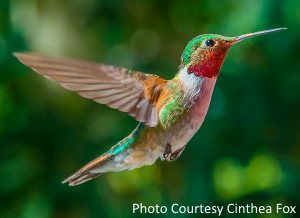 They have rather long, bladelike wings that, unlike the wings
of other birds, articulate (connect) to the body only from the shoulder joint. It is at this joint that the wing rotates almost 180
degrees to enable the bird to fly
in its distinctive way.
They have rather long, bladelike wings that, unlike the wings
of other birds, articulate (connect) to the body only from the shoulder joint. It is at this joint that the wing rotates almost 180
degrees to enable the bird to fly
in its distinctive way.
Other birds can generate power only on the down stroke, but hummingbirds can move freely in any direction.
Their wing architecture permits hummingbirds to fly not only forward but also straight up and down, sideways, and backwards and to hover in front of flowers as they obtain nectar and insects.
Hummingbirds are one of the few birds that can lift themselves straight up into the air. When they leave their perch, they rise into the air entirely on their own power and do not use the twig or branch as a brace to push against.
Although you hardly ever see them - yes they do have feet! They use their tiny appendages mostly for perching, unlike other birds that may hop or run about on the ground.
What do I do if I found a hummingbird?
Glenda Asked: I found a hummingbird alive on the ground, still can make a flying noise, but the tail feathers are short and can't get far up in the air. I am giving nectar to the bird but I don't know how often and how much to give. Is it possible the bird will fly again?
Bliss Said: The hummingbird may have hit a window or something similar and was stunned and may take awhile to fly again.
It's best to leave the hummingbird alone in a shady location or, if it can, leave it perched on a branch in a tree.
If it is still there after a hour or two, then there is probably something more seriously wrong with it, beyond what you can do. At that point, the only thing you can do is leave it or take it to your local wildlife rehabilitator.
Hummingbird tail feathers are typically very short when full length.
Even if all the tail feathers were missing, the hummingbird should be able to fly as the majority of the propulsion comes from the wing flight feathers; the tail is used more for steering.
Hummingbird Bill
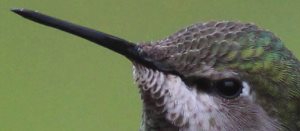 Hummingbird bills vary greatly in length & shape according to the flowers at which they feed. In fact, co-evolution of flower shape and bill shape is a well-studied
phenomenon.
Hummingbird bills vary greatly in length & shape according to the flowers at which they feed. In fact, co-evolution of flower shape and bill shape is a well-studied
phenomenon.
Some bills are slightly curved, some long & straight, some short. The main purpose of the bill is to enable them to reach nectar inside slim, tubular flowers.
Like woodpeckers, hummingbirds have a bony structure called a hyoid apparatus attached to the tongue. This pair of bony coils serves to extend the tongue for considerable lengths and pull it back in again like a spring.
Near its base, the tongue is flat and bears a slight groove along the middle.
Near its halfway point, it divides completely lengthwise, and each tip is pointed.
These 2 tongue sections roll up inwardly to create two tubes when the bird feeds. Nectar is not sucked up but held in the tubular portion and swallowed when the tongue is returned to the mouth.
The tongue collects nectar by means of a licking motion at a rate of about 13 licks per second, regardless of bird size.
Approximately 3.1 to 7.9 grams of nectar are consumed by a hummingbird at at feeder at one time.
Larger hummingbirds have larger tongues which will gather more nectar per lick. How many licks does it take to get to the center of a corolla?
We use the bill to help determine hummingbird age when mist-netting at our MAPS (Monitoring Avian Productivity & Survivorship) station.
Juvenile hummingbirds have soft, & deeply corrugated bills. In the first 5-9 months after fledging, the bill hardens & the corrugations are lost due to the hardening process and wear.
Hummingbird Plumage
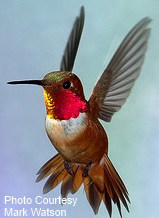 The brilliant, iridescent colors of their feathers have earned hummingbirds such names as "flying jewels." Audubon called the hummingbird a "glittering fragment of
the rainbow."
The brilliant, iridescent colors of their feathers have earned hummingbirds such names as "flying jewels." Audubon called the hummingbird a "glittering fragment of
the rainbow."
Hummingbird plumage is extremely varied. In general, upperparts are usually a glittering green, while the underparts are often paler, particularly in females.
In the Hermit subfamily, plumage color is generally brownish, grayish, or reddish and without iridescence.
Trochilines often have brilliant patches of iridescent feathers of metallic green, blue, purple, red or yellow usually on the crown, throat or upper breast.
The most typical patch is the gorget (think "gorgeous"), a bib of iridescent feathers that changes in color with viewing angle.
Females & young hummingbirds lack the distinctive gorgets of adult males. Before the first molt, which takes place at the end of the breeding season, young males have a mixed plumage, and may show some flecks of color.
All gorgets will appear black or dark if light does not reflect off them at a favorable angle. The sun, viewer and bird must be aligned properly to behold the sparkling plumage at its best.
Males may also have other adornments such as crests, "pantaloons" (tufts of puffy thigh feathers) or greatly elongated tails.
Feather counts on hummingbird range from about 940-1,500, depending on molt condition & season period.
As an extreme comparison, a whistling swan may have more than 25,000 feathers.
The hummingbird actually possesses more feathers per gram of body weight than the swan, which is to be expected since small bodies have relatively more heat-losing surface per unit of weight than large bodies.
Hummingbird Diet
Hummingbirds are nectarivores and insectivores; approximately 90% of their diet comes from nectar and 10% from arthropods (files, wasps, spiders, beetles, and ants).
A hummingbird requires an adequate diet of protein, carbohydrates, fats, vitamins and minerals.
Nectar is a dilute solution of sugars with trace amounts of amino acids
and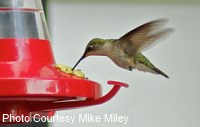 electrolytes.
electrolytes.
These sugars are easily digested and quickly converted into energy, supplying a hummingbird's carbohydrate requirements.
Learn how to make your own hummingbird food recipe so that its sugar concentration nectar is as close to what is naturally found in hummingbird pollinated flowers.
Insects are also part of a hummingbird's diet.
Insects provide protein, minerals, vitamins and fats and are digested more slowly than nectar.
Nevertheless, it takes only 10 minutes for the remains of some insects to pass completely through the hummingbird's body.
Some hummingbirds will snatch insects with their long bills right out of the air (hawking or hover-gleaning).
Other pick them from both inside and outside flowers and from underneath leaves.
They are also often hunted along walls, trees or flower bushes, and filmy webs are sometimes picked for tiny spiders or their prey.
Most straight-billed hummingbirds use both methods of hawking or gleaning, but the curved-billed hermits catch most of their insects & spiders by picking them off the tips, edges and undersides of leaves.
Metabolism
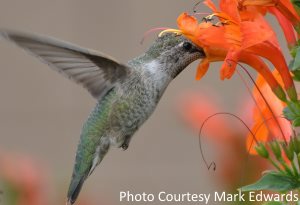 Because they are so small and operate at extremely high speeds, hummingbirds
require a lot of fuel to maintain their body temperature and their high rate of
metabolism.
Because they are so small and operate at extremely high speeds, hummingbirds
require a lot of fuel to maintain their body temperature and their high rate of
metabolism.
Food intake varies with temperature and activity but typically a hummingbird can consume 50% of its weight in sugar each day and not get fat. If only we could do the same with chocolate!
Compared to other birds, the metabolic rates of hummingbirds are extremely high.
For example, a 4-gram hummingbird has a basal metabolic rate of 1,400 calories per kilogram.
Compare that to a 121 gram mourning dove which has a rate of 127 calories per kilogram.
If humans had as high a weight-specific metabolic rate as a hummingbird, our daily intake of food would have to be approximately twice our body weight.
Also, our temperature would be over 750?F and we would use up 155,000 calories per day!
If a hummingbird needs to conserve energy, it becomes torpid at night.
This enables it to slow their metabolic & heart rates and reduce body temperature.
During periods of torpor the heartbeat slows from as many as 1,260 beats per minute to only 50 beats per minute.
They may appear dead during torpor states, but will quickly revive once the morning light & warmth arrives & are able to find food again.
Hummingbird Nest
Only the female hummingbird builds the nest, incubates the eggs, and feeds the young while the male is out goofing around. The male's only role is to contribute his genes during mating.
Below is footage of a Anna's hummingbird building a nest over a 10-day period.
Each species of hummingbird has its own particular type of nest, usually measuring about 2 inches in diameter. Some are cone-shaped and other look like tiny cups.
Locations vary. Some nests hang from ledges, while others are built on branches and still others can be found clinging to rocks. Some are even suspended by tendrils from nearby foliage.
Females begin by building a platform of various soft and strong materials, gluing them together with spider webs and other fibers. They will use these same fibers to attach the nest to its base as well.
The outside of the nest is camouflaged with bits of bark, moss, grass, lichen, and/or small roots so that is virtually indistinguishable, resembling a small bump on a branch.
The interior of the egg cups are extremely soft and thick, often made of cottony down, feathers, and/or leaves.
The female sits in the nest to shape it, turning frequently & pushing the sides with her breast. To shape the rim, she holds it between her chin & breast & moves from side to side.
It can take a hummingbird from one day to two weeks to build a nest depending on weather conditions and difficulty of gathering material.
Hummingbird Eggs
It should come as no surprise that hummingbirds lay the smallest eggs.
Elliptical in shape, they usually measure less than 1/2 inch and weigh less than 1/2 gram (not much bigger than a jelly bean!).
For a fun comparison, the ostrich egg is 6 1/2 inches long and weighs 1,400 grams.
Relative to a female hummingbird's size, the eggs she lays are quiet large.
Eggs may weigh 10-20% or more of her own body weight, compared to only 2-4% in other larger birds. I bet she's feeling relieved when they finally come out.
Anna's Hummingbird Eggs Hatching in Nest
Hummingbirds nearly always lay 2 eggs.
They tend to lay their eggs in the morning, and there is generally a 2-day spread between laying of eggs. Eggs are incubated for approximately 15-22 days.
A female hummingbird will generally sit on her eggs from 60-80% of every day.
She will not leave her eggs when it's cold or rainy, and on these days she will fluff out her feathers and press herself especially close to give the eggs as much warmth as possible.
When the weather is hot, she may hold her body off the eggs slightly or stand inside the nest to shade them from the burning sun.
Hummingbird Nestlings
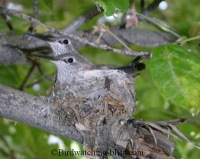 Newborn hummingbirds are altricial. They are blind, nearly featherless, and virtually helpless and in need of constant care.
Newborn hummingbirds are altricial. They are blind, nearly featherless, and virtually helpless and in need of constant care.
These hatchlings rely entirely on the mother for warmth until about 8-12 days when they are then able to maintain their own body temperatures.
The female sits on her nestlings (brooding) from 12-18 days, during which babies are fed from 1 to 3 times every hour.
Brooding periods vary with weather. Where there is abundant food and the weather is milder, the young may grow faster and leave the nest earlier.
The nestlings are fed by regurgitation, usually while the female is hovering.
The mother inserts her bill into the nestling's throat and pumps in nectar & insects.
Eventually, the nest becomes too small to hold the growing youngsters and they will perch on the rim.
Fledgling occurs in approximately 20-28 days. After leaving the nest, fledgling hummingbirds may be fed and preened by their mothers for as long as 20-40 days.
Like most mothers, hummingbird females are fearless when it comes to defending their nests and young.
They have been known to attack such large predators as hawks, crows, chipmunks & snakes.
Hummingbird Size Extremes
Smallest Hummingbird
The Bee Hummingbird (Mellisuga helenae) is the smallest of all hummingbirds, as well as the smallest of all birds, and one of the smallest warm-blooded vertebrates in the world.
It is found in Cuba, measuring a mere 2.25 inches (~6cm) in length and weighing only ~2 grams or 0.07; lighter than a penny or 2 paper clips! Awe, now that's cute!
Largest Hummingbird
The Giant Hummingbird (Patagona gigas) is the largest member of the hummingbird family, weighing 18-20 grams (6/10 - 7/10 of an ounce).
It's not fat, just big-boned! It measures 8.5 inches in length (~22cm), which is about the length of a an Eastern Kingbird, Gray Catbird, or European Starling.
It is found between 2,000 and 3,500 meters (6,500-11,000 feet) above sea level in the Andes of South America, from northern Ecuador to central Chile and Argentina.
Hummingbird Feeders, Nectar Recipe, Ant Problems:
Don't Use Red Dye in Hummingbird Nectar
Problems with Ants at Hummingbird Feeders
Hummingbird Gifts:
Hand-Blown Glass Hummingbird Feeders
Attracting Hummingbirds:
Hummingbird Species:
Hummingbird Fun Facts
|
Our Favorite Bird Watching Binoculars, Squirrel-Proof Feeder & Hummingbird Feeder Read Our Reviews: |
||
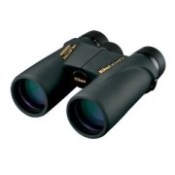
Nikon Monarch M5
Best mid-priced bird watching binoculars. Waterproof, shockproof, multi-coated ED-Glass. |
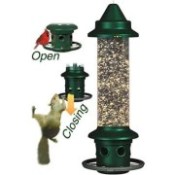
|
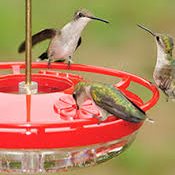
Best Hummingbird Feeder
Drip-Free, Ant-moat, Durable, Easy to Fill and Clean. |
| Click Images or Links To View More Info | ||
Subscribe to Our FREE Newsletter: The Birder Alert!
